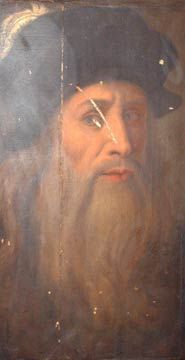Découverte d'un autoportrait de Leonard de Vinci ?
Ordre Souverain et Militaire du Temple de Jérusalem
Un tableau qui pourrait être un portrait de Léonard de Vinci (1452-1519) a été découvert dans le petit village d'Acerenza, dans le sud de l'Italie, révèle lundi 23 février le site Internet du Times. On y voit un homme au nez aquilin, yeux bleus et longue barbe blanche, coiffé d'un chapeau à plume.
La toile a été retrouvée par hasard par Nicola Barbatelli, historien spécialiste du Moyen Age, alors qu'il effectuait des recherches dans les archives d'une riche famille italienne. Pendant un temps, les experts ont cru que l'homme représenté sur le tableau était Galilée, le grand astronome italien. Mais Nicola Barbatelli a rapidement fait le lien avec un autre portrait de Léonard de Vinci. "La posture, le style et la technique rappellent le portrait de Léonard" présent à la galerie des Offices de Florence, a expliqué le chercheur.
"PINXIT MEA"
Selon les experts, il s'agirait d'un portrait original daté de la Renaissance et non d'une copie. Il se pourrait également que l'on soit en présence d'un autoportrait de l'artiste : les mots "Pinxit Mea" (peint par moi) écrits à l'envers, marque de fabrique du peintre-inventeur, ont été décelés à l'arrière du tableau. Une hypothèse d'autant plus plausible que, selon Nicola Barbatelli, Léonard de Vinci avait des liens avec une famille florentine qui possédait des terres à Acerenza. Si cette thèse était avérée, ce serait seulement le deuxième autoportrait authentique du génie italien identifié par les spécialistes, le premier étant entreposé à la bibliothèque royale de Turin.
Si la toile est actuellement étudiée par des experts, on sait d'ores et déjà qu'elle sera intégrée dans quelques jours à une exposition italienne ayant pour thème Léonard de Vinci, à Vaglio, en Italie. Lucile Sourdès www.lemonde.fr
 What may be a hitherto unknown portrait of Leonardo da Vinci in middle age shows that the Renaissance genius had piercing blue eyes, a long nose and long greying hair with a droopy moustache.
What may be a hitherto unknown portrait of Leonardo da Vinci in middle age shows that the Renaissance genius had piercing blue eyes, a long nose and long greying hair with a droopy moustache.
The damaged oil-on-panel portrait was discovered by Nicola Barbatelli, a medieval historian, while he was researching the archive and picture collection of an aristocratic family at Acerenza (population 3,000), an ancient village perched on a rock above the river Bradano near Potenza in the southern Italian region of Basilicata. The family has asked to remain anonymous.
At one time thought to portray Galileo Galilei, the great astronomer, it shows a man in three-quarter profile wearing a hat with a feather in it. Mr Barbatelli, who found the painting by chance while researching the history of the Templar Knights and the First Crusade, told The Times that although Leonardo came from Vinci in Tuscany and worked in Florence and Milan, he was known to have visited Basilicata.
Mr Barbatelli said that the 60cm-by-44cm (24in-by-17in) painting could even be a self-portrait, since it bore on the back the words “Pinxit Mea” written in reverse, which was one of Leonardo’s trademarks. “We know that Leonardo had ties to a Florentine family, the Segnis, who had property in Acerenza in the Sixteenth Century,” he said.
Alessandro Vezzosi, director of the Museo Ideale Leonardo da Vinci at Vinci, where the artist was born in 1452, said initial examination of the painting showed it was a Renaissance era original and not a later copy. He said he was investigating whether the painting was by Cristofano dell’Altissimo, who painted the da Vinci portrait in the Uffizi Gallery in Florence.
Only one self-portrait of da Vinci is widely accepted as authentic, a red chalk on paper 1512 drawing held at the Biblioteca Reale (Royal Library) in Turin, which shows him in old age. A figure in Raphael’s School of Athens in the Vatican is also thought to represent Leonardo, and resembles the Acerenza portrait.
Announcing the discovery on the Museo Ideale website, Professor Vezzosi said that the newly found portrait was “very interesting in itself, and potentially important as a new element in helping to put together the mosaic of what Leonardo looked like.” He said that it could also add to “our knowledge of Leonardo’s links with the South of Italy as well as the North”.
Its date and provenance still had to be established “with certainty” however. He told the Discovery Channel that the plume on the hat might have been added at a later stage, and that one eye appeared to have been repainted. “I also have some doubts about the mouth,” he said.
Mr Barbatelli said: “I could see at once it was not Galileo. The posture, the style and technique were reminiscent of the portrait of Leonardo in the Uffizi”. He too stressed that the painting needed to be “subjected to more tests”, adding “we are only at the beginning”.
The portrait is to go on show at the end of next month as part of an exhibition on Leonardo at a recently opened museum at Vaglio, near Potenza, together with other paintings, drawings and documents loaned from the Museo Ideale.

/https%3A%2F%2Fprofilepics.canalblog.com%2Fprofilepics%2F1%2F0%2F100183.jpg)



/http%3A%2F%2Fstorage.canalblog.com%2F68%2F36%2F577050%2F61600378_o.jpg)
/http%3A%2F%2Fstorage.canalblog.com%2F34%2F86%2F119589%2F59727368_p.jpg)
/http%3A%2F%2Fstorage.canalblog.com%2F61%2F80%2F119589%2F59307471_p.jpg)
/http%3A%2F%2Fstorage.canalblog.com%2F19%2F03%2F119589%2F57176378_p.jpg)